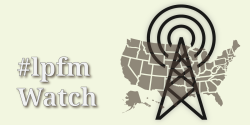Four more LPFM construction permits were granted in the last week, but the big news is that the FCC released its list of 79 MX groups for states west of the Mississippi, as we reported yesterday. These are groups that are competing for a single frequency in their respective communities.
Now these applicants have the choice of working amongst themselves to resolve the competition, or the FCC will apply its point system to choose a winner. Another option is for two or more applicants to join forces and enter a time-sharing agreement. In groups of 3 or more applicants this might give the time-shared arrangement the extra oomph to win the license.
The applicants have 90 days to make these time-sharing arrangements or other amendments to their applications. There is also a 30-day period for interested parties to file petitions to deny with the FCC.
REC Networks has created an easy-to-read web page of all the groups, indicating how many points each applicant has. The groups with the most points are shaded in yellow to indicate that they are “tentative selectees.” The Commission has been adjusting the number of points that some applicants have. For instance, Portland State University in Oregon lost the diversity point because the school has other media holdings, and Veterans for Peace in Corvalis, OR lost a point for improperly claiming tribal status. These changes are reflected in the REC Networks list.
Original LPFM Proposer Says the Service is “Incomplete”
Don Schellhardt is one of the first two persons to propose the modern low-power FM service to the FCC. Last week he wrote an Op-Ed for Radio World in favor of further expansion of LPFM, arguing that the current 100-watt service is “incomplete.”
Schellhardt and engineer Nick Leggett filed a petition urging the Commission to allow selected rural stations upgrade to 250 watts, but only in areas outside densely populated Metropolitan Statistical Areas. Additionally, he advocates 50-watt stations, which he says REC Networks’ Michelle Bradley has agreed to petition the FCC on, as well as 20-watt stations for big cities.
He also argues for letting select translator repeater stations be permitted to originate local service programming. Translators are a type of low-power station that is subordinate to full-power stations, but there is great deal more flexibility in their power levels than with LPFM. However, translators may only repeat another full-power station’s signal.
Finally, Schellhardt also urges the FCC to reopen a docket on low power AM radio as part of the Commission’s proceeding on revitalizing that radio band.
That’s quite a slate of proposals, though Schellhardt says, “all of this unfinished business can probably be resolved within two years, or less, if the commission is motivated and supporters are vocal.” That may be, but it’s an uphill climb.
That said, when Schellhardt and Leggett filed their LPFM petition back in 1997, most observers in the industry thought that it was a fool’s errand. But due to their hard work, along with many other LPFM groups and supporters, the service is a reality today. The lesson is: don’t doubt the low-power radio dreamer.



